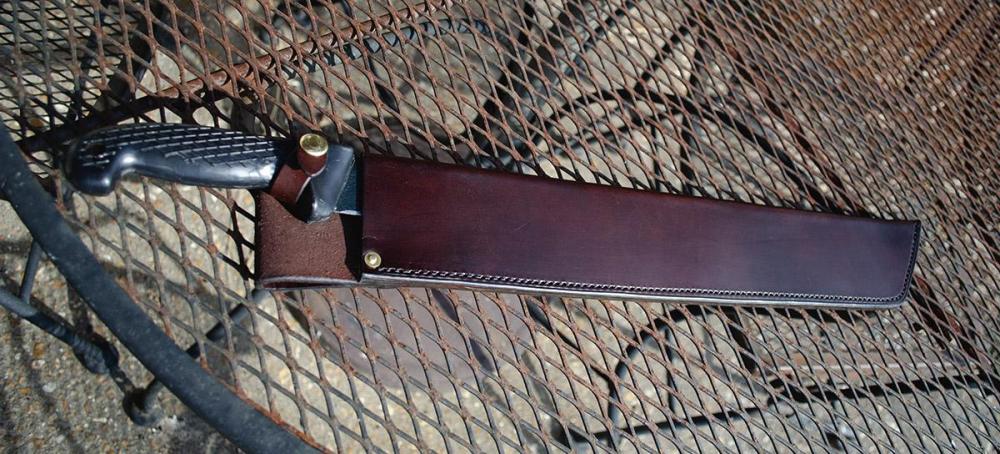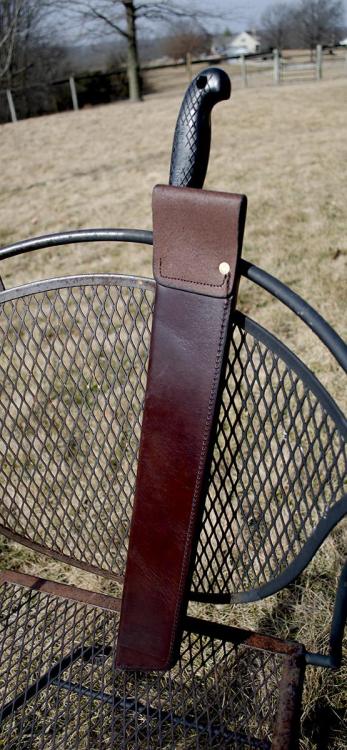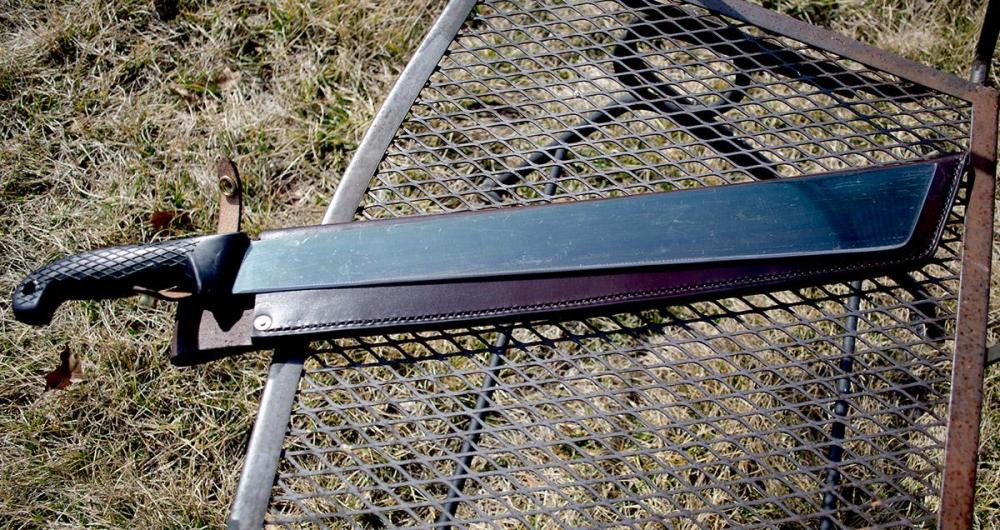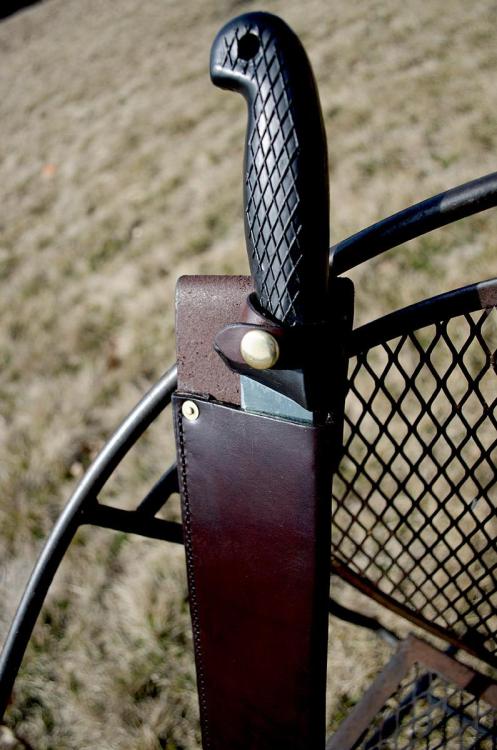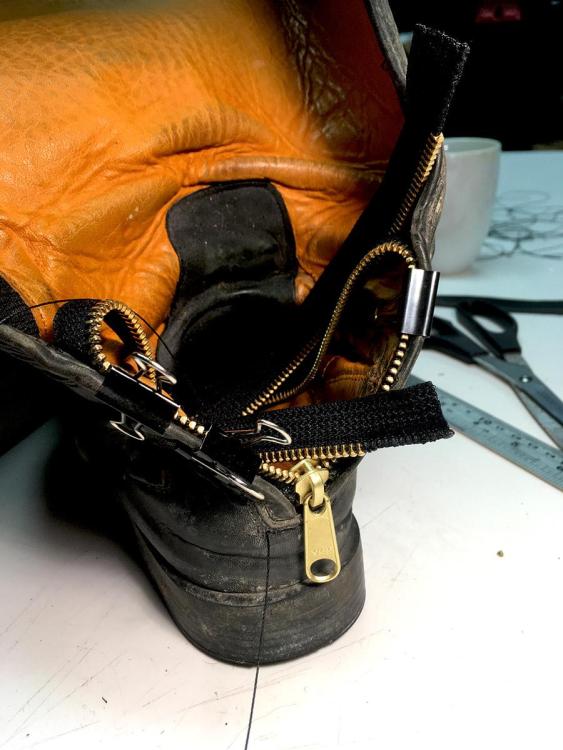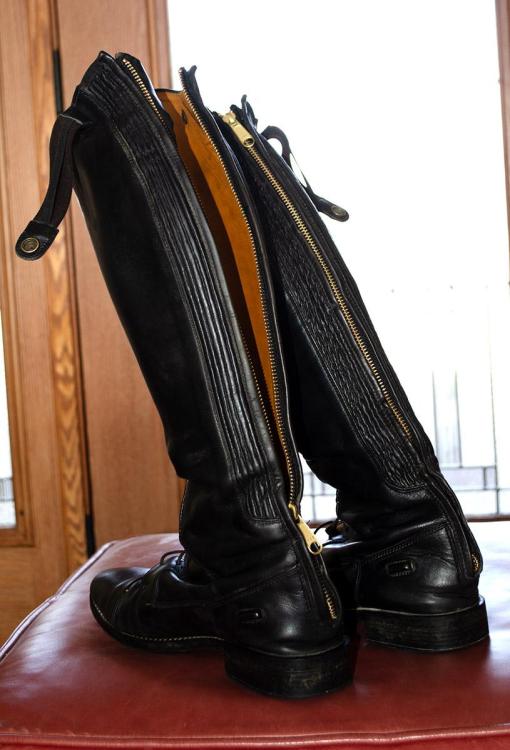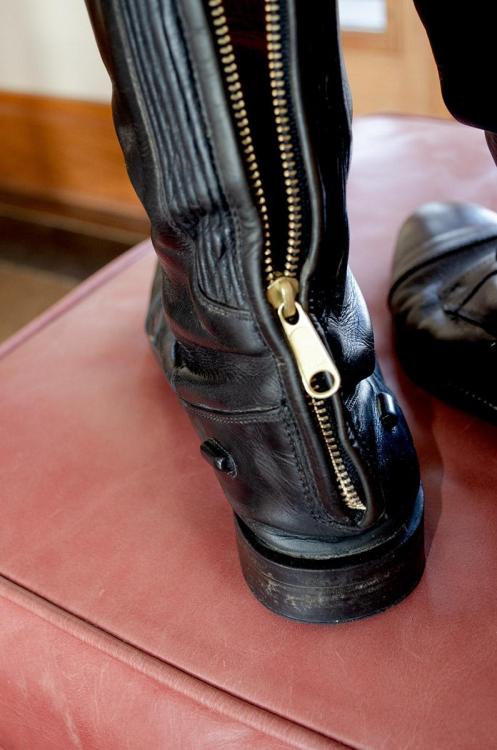-
Posts
1,284 -
Joined
-
Last visited
Content Type
Profiles
Forums
Events
Blogs
Gallery
Everything posted by TomE
-
I usually mark holes after forming the strap around hardware, but I could then unfold it so I can awl the top layer before gluing/assembly.
-
We all agree it is tough to awl through that many layers, and it's great for me to read everyone's methods. I use a peg awl haft with a 2" awl for the heaviest sewing that I do. https://osborneleathertools.com/product/peg-awl-haft-143/ It's probably the wrong tool for leather sewing but I have gotten the feel of it to reach my destination on the backside of a stack of straps.
-
That's an interesting design that I hadn't seen before. Looks indestructible and very well made. I like the way the 2 straps wrap around the dee ring. As it turns out, we sold our phantom yesterday. I am getting too old for that stuff. We previously kept pony stallions for breeding children's hunter ponies based on the Caspian Horse. I then collected a friend's stallion for shipment for several years, but he was a well behaved boy. Now all of our warmblood breeding is using mail order husbands for our mares. Young colts are about as much stallion as I can handle these days, and I can only blame myself if they are poorly behaved.
-
After struggling for several years with burnishing bridle leather I’ve learned a key is to get the right amount of moisture and friction when burnishing and not overheating with a power burnisher. When in doubt, burnishing with canvas is a good approach. My favorite dye applicator is a small block of Magic Eraser held in a clothespin. Holds a lot of dye without dripping.
-
If I may suggest finishing and sealing the edges for outdoor use. This will help repel dirt and moisture to improve wear. I use mostly bridle leather for tack. It is a bit trickier to burnish than plain veg tan because the fibers are stuffed with fats and oils. You can get a fairly smooth edge by burnishing without sanding. My process is to bevel the edge then lightly wet it with water. I apply a small amount of saddle soap with a finger - just enough to feel it starting to get slick. Too much water or saddle soap will decrease the amount of dye absorbed in the subsequent step. I use a power burnishing wheel but canvas also works well to make the first pass. I then dye the edge with Pro dye or a 50:50 mix of Pro dye and Martin's Edge Solution. Once the dye soaks in I add a little saddle soap and burnish again. Gum tragacanth also works at this stage instead of saddle soap, but GT will seal the edge so you can't apply more dye if needed. Martin's Edge Solution creates a firm edge that is not sealed. I burnish before and after dyeing because it's easier to apply the edge dye evenly on a smooth edge. I usually finish by sealing the edge with beeswax applied with a heated edge iron. I let the wax harden for several hours before buffing with a soap cloth. This makes a serviceable edge for horse tack. I avoid acrylic finishes so the tack can be cleaned and conditioned as needed.
-
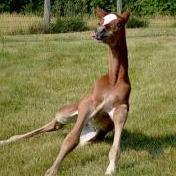
Beveling edges - I just keep getting worse at it, and it ruins my projects
TomE replied to Toffe's topic in Getting Started
Placing the edge to be beveled on a scrap of heavy leather is a good idea to gain some room. I do a lot of edges on small bridle parts that vary in thickness. Of course having the correct size edger and keeping it sharp will help the cause. I have scraps of heavy oil tanned leather that I've edged with various edgers and coated the beveled edge with polishing compound. I frequently strop my edgers on these scraps. Can also coat a leather edge with beeswax and add some aluminum oxide powder for a coarser/sharpening step before stropping. I bought the Weaver block-of-wood-with-leather-strips for polishing edgers but rarely use it. -
Thanks for the tip, @Northmount! I am finding all sorts of posts about bridle leather, horse tack, etc that I previously missed. Dreaming up lots of experiments based on new information.
-
Work of art! Beautiful craftsmanship.
-
A raised leather strap is typically made by splitting the strap and inserting a leather filler strip. The top/grain side is thin (~2-3 oz) so it conforms to the filler strip and the bottom of the split is thicker and serves as a flat platform. I make raised leather straps from bridle leather with a pasted back, but you could split 2 straps or add a thin liner if you want grain showing on both sides. The layers are glued together before sewing the edges. The width of the top cover is decreased by wrapping over the filler strip so the edges of the strap will need to be trued up after it is assembled. Depending on the height/shape of the filler you might need to start with a wider strap if you're machine sewing so the pressor feet have a place to land then trim the margins after sewing. An inline or narrow pressor foot helps with sewing next to the raised element. It takes some practice with splitting, shaping, sewing, and trimming to make raised elements. Also, the pictured belt violates a cardinal rule of strap making - don't stitch across the width of the strap - although this is often seen in manufactured dress belts.
-

TandyPro - 35mm Japanese Style Flat Knife - Any Good?
TomE replied to CalgaryJim's topic in Leather Tools
One of my favorite skiving knives is this cheap knockoff https://a.co/d/58YIeFR. I did reprofile the blade before we became friends. It holds an edge reasonably well, especially for what it cost. My other favorites are rounded blades including an Osborne #67 and a Dozier half round knife. So my philosophy is there are a lot of tools that will do the job and I just need to work on the blade until I'm happy with it. -
Harry Rogers also has a book on hand making shoes. Haven't made any but it's entertaining to read. https://www.amazon.com/MAKING-HANDMADE-SHOES-STEP-STEP/dp/B0BM57TF35
-
The best sources of bridle leather made in the USA are Hermann Oak and Wickett & Craig. I have more experience with HO bridle, which is firmer than W&C in my experience. I have been pleased with HO purchased from Springfield Leather and Beiler's. I have purchased W&C bridle directly from them, and Beiler's also sells it. For making tack, I typically get good straps more than half way down a side of HO bridle. Look at the cost/sq. ft. for the bends vs. a side. I consider the shoulder and belly to be free leftovers from a side, and I use them for smaller projects.
-
We've used repair snaps for nylon halters but I hadn't seen repair buckles. Aaron Martin also has repair type heel bar buckles in 3/4" and 1." Good info.
-
Abbey England sells Equus grips with either large pips or small pips. The small pips are more grippy and seem to be preferred by the riders I know. I suspect the large pips will last longer. I have been pleased with the quality. Note that the size refers to the width of the leather strap that the grip fits over. I mostly use 5/8" grips and the rubber grip is about 3/4" wide.
-
@bruce johnson will hopefully see this and share his expertise.
-

A little something for myself
TomE replied to chiefjason's topic in Gun Holsters, Rifle Slings and Knife Sheathes
Good looking construction and finish work. Very nice. -
Thank you all for your kind comments. My neice says she uses the machete often and the sheath will keep her safer than the nylon cover she had been using. She ties the machete to her pack when not in use.
-
Well this turned out kind of clunky, but it's the best I could come up with for this blade. My first sheath, for my niece the archeologist. She does underground imaging of old and new objects and sometimes bushwhacks her way to work. I sharpened the blade so she will also be ready for a zombie apocalypse.
-
The Leather Crafters and Saddlers Journal's online store has books and DVDs(?) on various carving techniques.
-
Like the unique artwork. Very pretty. The edges could be more finished. Shaping the rounded corners on a drum or belt sander before edging, sharpening/stropping the edger to get a clean even bevel, a bit more burnishing work. Thanks for posting.
-
That's outstanding (may I say awesome?) work. Makes me think about taking up smoking. How did you cover the button? What is the cord made of and how did you dye it? Thanks for sharing.
-
Thanks. Just tedious work. All's well that ends well. I am told there's a robust market for replacing these zippers on boots costing $300-$500+. This one was learning/practice done for a friend. I think I'd charge $80 for the repair. About 1 hr per boot with the hand sewing. Not sure if a patcher could sew around the heel end of the zipper. I used a small cylinder arm machine to finish sewing the sides. Thanks, @Dwight. Another fellow pointed me to a strong adhesive basting tape sold by Wawak sewing supplies. It appears to be heavier tape than the double sided tape sold by office supplies. If it works it would be faster than glueing. Thanks, Ron. Yes, they scare me too. I think with the basting tape I mentioned above I might be able to place the closed zipper in the boot, avoiding wrinkles especially near the heel, then open the zipper to sew it in place.
-
Pit of despair. Sewing a zipper into the heel of a riding boot. First time installing a zipper. I welcome your tips and advice. My double stick tape didn't stick to the leather so I used a dab of Barge cement on the bottom and binder clips to hold the zipper for sewing. I hand sewed the zipper into the heel then used a machine for the rest.
-
Bob Klenda sells chaps patterns from his saddle shop. https://www.klendasaddlery.com/patterns.html I think I read that he recently has published a book on chaps making that he hopes will be used as a textbook in leathercraft classes.
-
Typically have to prove gross negligence to claim liability. Since she had a snow removal service treat her driveway she has a good case. We have guests sign a liability release that explains the risks when trying out a horse or pony on our property, but we are still liable for "gross negligence." We require a helmet, have our trainer present during the ride, etc.



